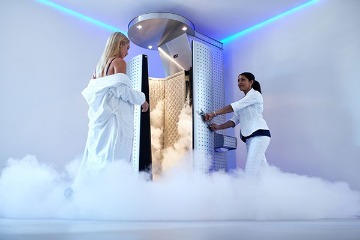What is Whole Body Cryotherapy?

Whole Body Cryotherapy (WBC) is a therapeutic technique that involves exposing the entire body to extremely cold temperatures for a short duration, typically ranging from -130°F to -184°F. The process takes place in a specialized cryotherapy chamber, often referred to as a cryosauna, where individuals stand while the cold air circulates around them. The experience is brief, lasting around 2-3 minutes, but the effects are profound.
History of Cryotherapy:
The roots of cryotherapy can be traced back to the 1970s when it was first introduced by Japanese rheumatologist Dr. Toshima Yamaguchi. Dr. Yamaguchi initially used it to treat rheumatoid arthritis. Over the years, the practice gained popularity in Europe, particularly in countries like Poland and Germany, where it was embraced for its potential in alleviating pain and inflammation associated with various conditions.
The therapeutic use of cold has ancient origins, with cultures throughout history incorporating cold exposure into their healing practices. However, the development of modern cryotherapy, specifically Whole Body Cryotherapy, is a relatively recent phenomenon.
How Whole Body Cryotherapy Works:
Preparation:
- Before entering the cryotherapy chamber, individuals are typically required to change into minimal clothing, ensuring maximum exposure to the cold. Protective gear, such as gloves, socks, and earmuffs, may also be worn to safeguard extremities.
Cryochamber Entry:
- Once inside the cryosauna, the temperature is rapidly lowered using liquid nitrogen or refrigerated cold air. The extreme cold triggers a systemic response in the body.
Vasoconstriction:
- The cold exposure causes blood vessels on the skin’s surface to constrict, directing blood flow away from the skin and toward the vital organs. This is a natural protective response to conserve heat.
Activation of the Nervous System:
- The sudden drop in temperature stimulates the skin’s cold receptors, sending signals to the brain. This activates the central nervous system and prompts the release of endorphins, the body’s natural feel-good hormones.
Anti-Inflammatory Response:
- The reduced blood flow to the skin during cryotherapy leads to a decrease in inflammation, providing relief for those dealing with inflammatory conditions or injuries.
Post-Cryotherapy Rewarming:
- After the brief exposure, individuals exit the cryochamber, and the body quickly returns to normal temperature. The enriched blood, carrying oxygen and nutrients, flows back through the body, promoting healing and recovery.
Potential Benefits of Whole Body Cryotherapy:
Pain Relief:
- WBC is often used to alleviate pain associated with various conditions, including arthritis, muscle soreness, and chronic pain disorders. The exposure to extreme cold is believed to reduce inflammation and numb nerve irritation, providing temporary relief.
Muscle Recovery and Performance Enhancement:
- Athletes frequently turn to WBC to accelerate muscle recovery after intense training sessions or competitions. The cold exposure helps reduce muscle soreness and inflammation, allowing athletes to recover faster and potentially enhance their overall performance.
Reduced Inflammation:
- Cold exposure triggers a natural anti-inflammatory response in the body. WBC is thought to decrease inflammation, making it appealing for individuals dealing with inflammatory conditions or injuries.
Increased Metabolism and Weight Management:
- The intense cold exposure during WBC stimulates the body’s metabolic rate. This increased metabolic activity may contribute to weight management efforts by burning additional calories.
Enhanced Mood and Energy Levels:
- Cryotherapy prompts the release of endorphins, the body’s feel-good hormones. Many individuals report an improved mood and increased energy levels following a WBC session, which may be beneficial for mental well-being.
Improved Sleep Quality:
- Some individuals claim that WBC helps improve their sleep quality. The release of endorphins and the potential reduction in pain and inflammation could contribute to better rest and recovery.
Skin Rejuvenation:
- Cold exposure during WBC is believed to stimulate collagen production and improve skin tone. As a result, some people use cryotherapy as a beauty treatment to promote healthier and more youthful-looking skin.
Boosted Immune System:
- The brief exposure to extreme cold may stimulate the immune system. Some proponents argue that WBC can help strengthen the immune response, potentially reducing the likelihood of getting sick.
Stress Reduction:
The release of endorphins, coupled with the overall invigorating experience of WBC, may contribute to stress reduction. Some individuals find the brief exposure to extreme cold to be a calming and rejuvenating experience.
